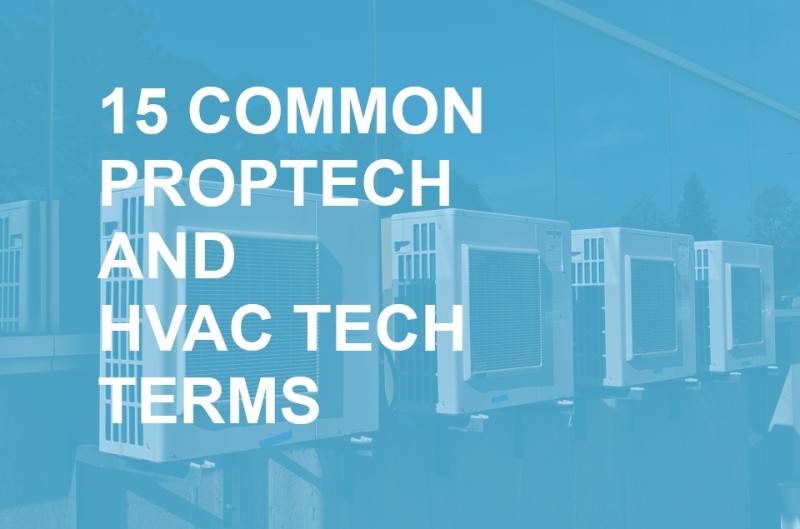Environmental sustainability, saving time and energy, improving the overall well-being of residents, and maximizing cost savings are important aspects and topics for multi-family and commercial building managers. Understanding and maximizing these areas can be accomplished by proactive data-driven decisions that begins with property technology – or PropTech.
Here are 15 PropTech and HVAC technology terms that can help you understand how get the most out of your properties:
HVAC Asset Tagging / Management
Asset tagging helps manage physical HVAC capital and assists in making informed decisions regarding the repair and replacement of your systems. Motili’s asset tagging process takes inventory of all HVAC and hot water units at every property, and provides a 360 degree view of asset condition, efficiency, brand and age. In turn this data provides mutlifamily and commercial owners and operators with detailed information across a property or an entire portfolio of properties.
Capital expenditure (Capex)
The funds required to acquire and maintain physical assets. The capital expenditure for your HVAC system would consist of the cost to acquire the system and the cost to maintain and improve it.
CRETech
Technology solutions for commercial real estate. Commercial real estate technology is a broad term that encompasses smart buildings, IoT, hardware and software, and other technology applications in commercial real estate.
ESCO
Stands for Energy Service Company. A company that delivers energy services, energy efficiency improvements, energy conservation, and risk management. These consultancies focus on improving operational efficiency of building systems. Energy savings may take the form of lowered maintenance costs through preventative maintenance programs, reduced energy cost via properly installed and well functioning building systems, and through energy savings.
Green Buildings
Green buildings refers to a structure that focuses on conservation of the climate and natural environment during all aspects of creation. From design, construction, operations, and maintenance, green buildings focus on creating less environmental impact and focus on sustainability. Examples of aspects that contribute to these buildings are the use of high efficiency HVAC systems, using low volatile organic compounds during painting and flooring, as well as recycling construction waste.
High Efficiency HVAC
High efficiency HVAC systems use less energy to power and give off fewer emissions. These HVAC systems retain an Annual Fuel Utilization Efficiency (AFUE) of at least 90% and retain a SEER rating over 16.
IAQ
Stands for Indoor Air Quality, aka the air quality within and surrounding buildings. IAQ refers to the health, comfort, and overall well-being of those encountering the air. Aspects that influence your air quality include indoor pollutants, high temperatures, and humidity. A few of these factors include:
- Carbon Monoxide: A colorless and highly toxic gas emitted by the burning of fossil fuels, cigarette smoke, and human respiration. It is important to ensure your heating appliances are installed and maintained property.
- Volatile Organic Compounds (VOCs): Emitted gases from liquids or solids that tend to be higher in concentration indoors than outdoors. These gases can be emitted from products such as paints, cleaning solutions, and cosmetics. It is important to increase your ventilation when using products that emit VOCs as if they’re inhaled in high levels, you can experience adverse health effects.
- Particulate Matter: A combination of small solid and liquid particles such as chemicals, metals, and dust found in the air that can lead to health problems if inhaled in large quantities.
- Household Activities: The use of harsh chemicals from housekeeping and pest control, smoking and personal hygiene, as well as remodeling can affect how clear your air is.
- HVAC System: Certain factors such as inadequate distribution of fresh air, lack of clean ductwork and air filters, and microbiological growth within areas of your system can negatively affect your air quality.
- Asthma Triggers: Airborne particles such as pollen, tobacco smoke, mold, dust, and dander lingering in the environment can lead to unclean air and cause asthma attacks.
IoT – Internet of Things
Stands for the Internet of things and consist of physical objects with software and sensors embedded within them so they can exchange important data over the internet.
Operational expenditure (Opex)
An ongoing cost for running a product, system, or business. The operational expenditure for an HVAC system is the cost to run the system.
Smart Building
Automations of the building operations such as heating, ventilation, air conditioning, security, and other utilities. The software and sensors in smart buildings help facility managers track and improve the performance of their properties.
Smart City
Smart cities are those that use technology to track and analyze data to communicate to improve the operations and lives of citizens, business, and developers. By the use of PropTech and IoT, smart cities can track the air quality, lighting, waste management, and manage traffic.
Smart Home
A home that is equipped with the technology to control household operation though a phone or computer.
Total Cost of Ownership
Consists of the purchase price of a particular asset as well its operation and management costs of its lifespan. The total cost of ownership of your HVAC system includes the cost to acquire it, maintain and repair it, as well as the cost to operate it.
Zero Net Energy
Buildings with zero net energy only consume as much as energy as they produce during a specified period of time. These buildings are efficient and generate clean renewable energy onsite.












